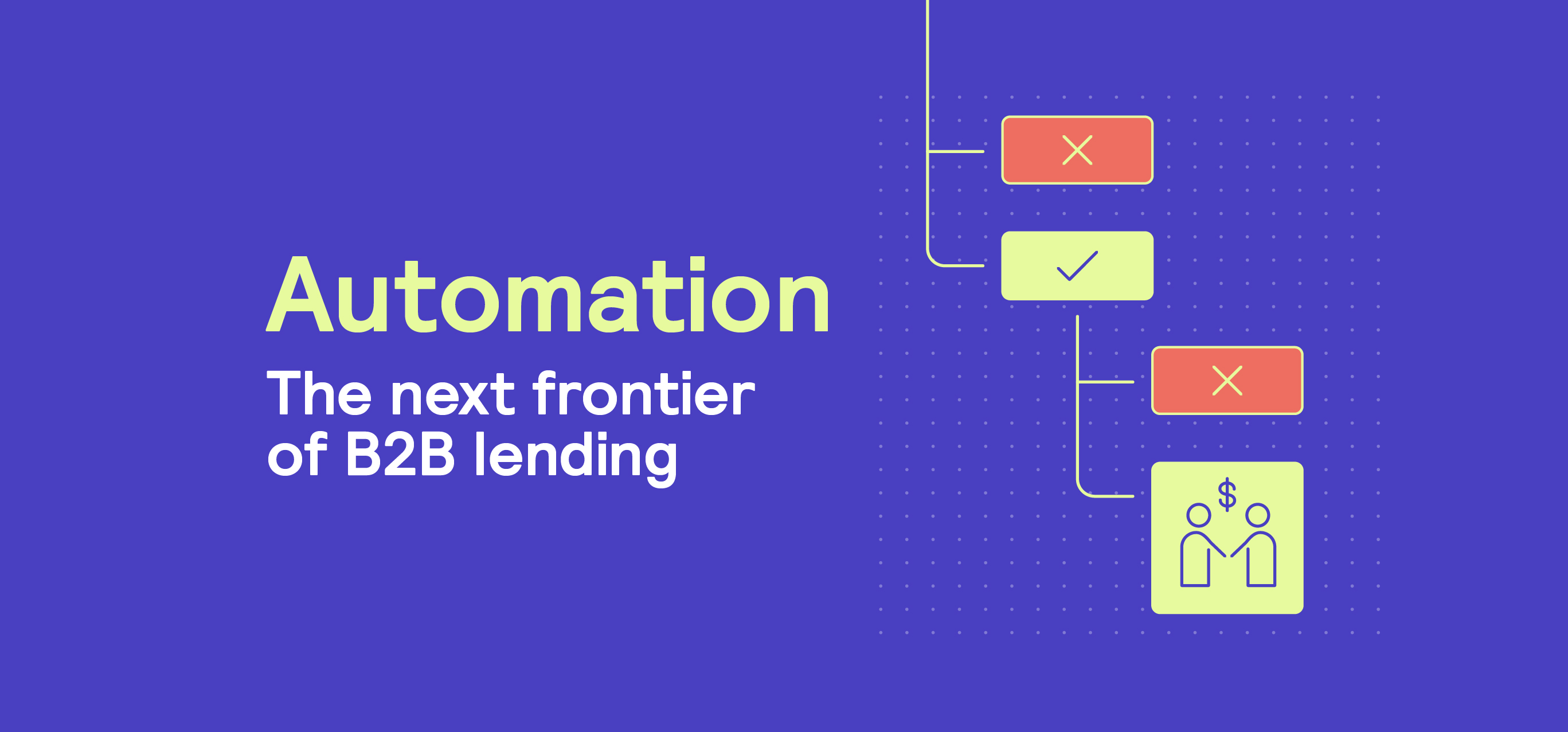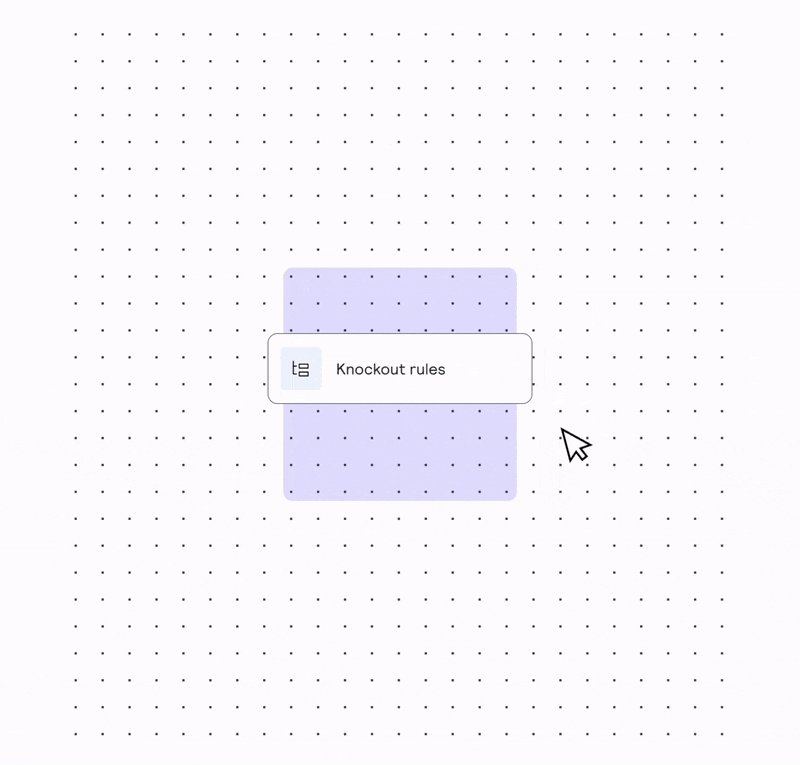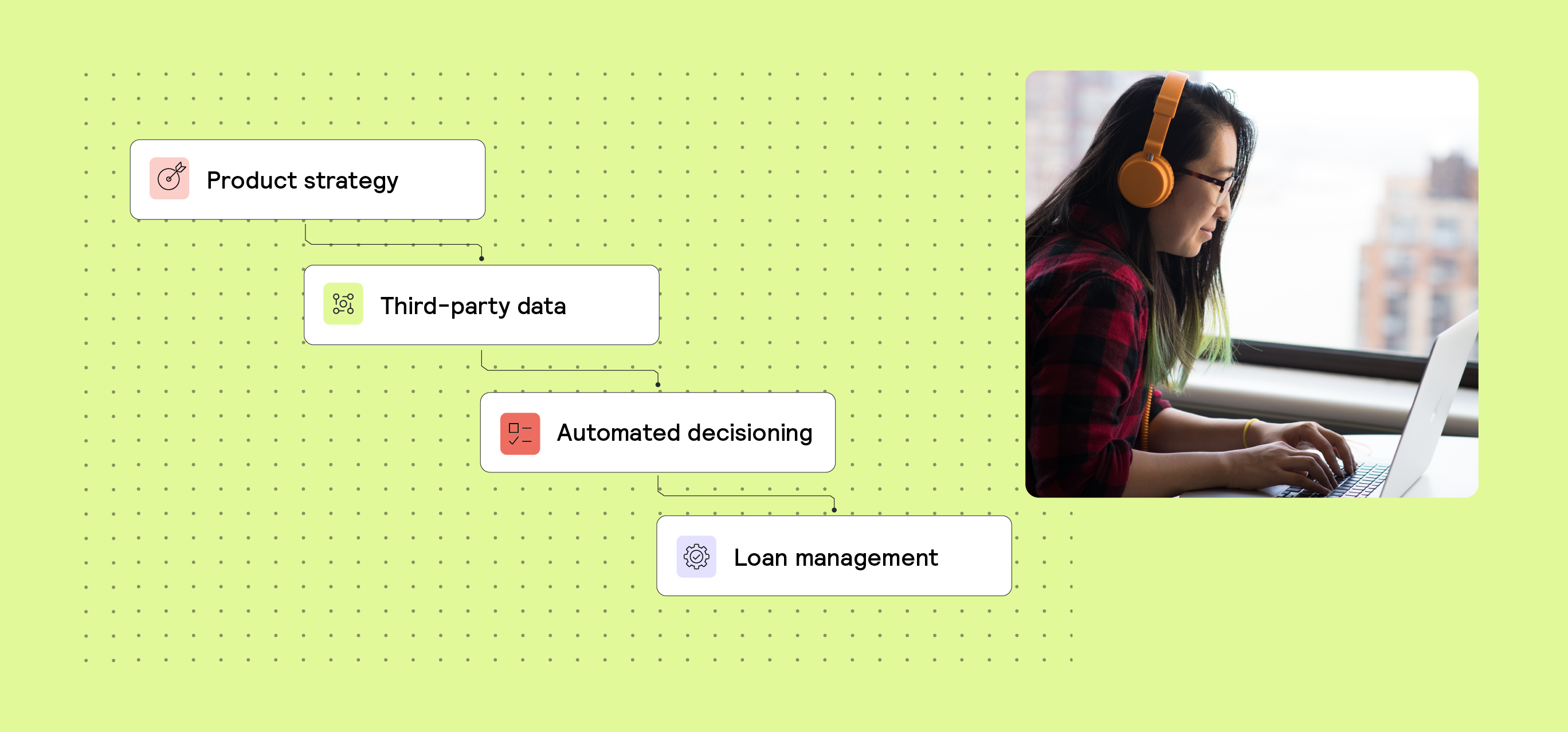
As a result of significant innovation in the fintech sector, B2B lenders now have the opportunity to transform their operations. The automation of underwriting processes is finally possible, meaning lenders can scale their businesses without having to increase spend and resources.
In this article, we provide insight into how automation can transform your operations to make faster, smarter, and safer underwriting decisions at scale.
Key takeaways
- Automating B2B underwriting reduces manual workload, speeds up decisions, and lowers operational costs while improving consistency and transparency.
- Start small: even partial automation of pre-screening or data collection can significantly boost speed and accuracy.
- Gradually expand to automated risk assessment and pricing, while keeping human oversight for complex or high-value cases.
- Use high-quality, integrated data sources like open banking and accounting data to improve risk assessment accuracy and enable instant offers.
- Target automation for lower-value, high-volume segments first to increase capacity and capture revenue from previously underserved customers.
- Continuously experiment and refine credit policy rules to maximize the accuracy and efficiency of automated underwriting decisions.
Resource drain: How manual underwriting processes inhibit growth at scale
For decades, B2B lenders have struggled to standardize their approach to assessing risk.
Businesses have distinct traits and often require more financial support than consumers. When deciding whether to provide financing, lenders require a lot of paperwork from borrowers, which is then carefully reviewed. As a result, a substantial amount of B2B underwriting is done manually.
A major challenge of manual underwriting is the cost. It takes considerable time and resources to make a decision, and scaling operations effectively can be almost impossible. For instance, manually reviewing hundreds of documents for a single applicant is difficult to do at scale.
These constraints mean lenders often turn down requests for lower-value loans from SMEs, for example. In addition, a 100% human review process can result in inconsistencies and a lack of transparency in the decision-making processes.
Manual underwriting processes also directly affect a product offering. Applications are complex, and offer timeframes are much slower.
For a long time, B2B lenders have had to operate within these parameters. However, this is no longer the case.
The next frontier of B2B lending is decision automation
With advancements in automation software and data availability, B2B lenders have the opportunity to introduce more automation into their underwriting processes. Those at the forefront of the industry are already leveraging these technologies to scale their operations successfully.
In a recent Taktile study, 73% of B2B lenders disclosed that they want to increase their automation levels in 2023, with 27% wanting to grow their decision automation by over 10 percentage points.
The benefits of decision automation in B2B lending
- By automating even just part of your underwriting process, you can significantly reduce the amount of time and resources required to make decisions – and as a result, increase your capacity to make a higher volume of decisions.
- Combining human review with data-driven automation can drastically increase the accuracy and consistency of your risk assessment capabilities.
- In terms of your borrower experience, automation enables you to streamline your application process, speed up your offer timeframes, and offer more attractive pricing.
These factors not only reduce your operational costs but can also be the catalyst to improving conversion rates and growing revenue by serving customers you may have previously turned away.
How to increase the automation of your underwriting decisions
To get these benefits, lenders around the world are using modern decision solutions, such as Taktile. These solutions help lenders turn their credit rules into automated decisions and use data to make better decisions.
However, given the complexity of business risk assessment, lenders often cannot automate 100% of their decisions. This is why many lenders start with a gradual automation approach.
1. Start out with small improvements
For some, automating just one or two steps of a manual underwriting process can have a huge impact.
For instance, using a tool that visualizes your credit policy in a straightforward way and automates data collection can significantly improve the speed, accuracy, and consistency of your decisions.
2. Expand into automated risk assessment and decisions
Next, you can progress to creating a decision flow that automatically evaluates part (or whole) of an underwriting decision.

For example, you may start by automating just the prescreening of borrowers, then evolve to automating the entire risk and pricing assessment – ensuring there is always someone in your organization to review and approve (or decline) final decisions.
“By automating our risk assessment using Taktile’s decision engine, we’ve been able to significantly reduce the amount of manual input in our underwriting process. Our teams are able to collaborate on underwriting decisions even more effectively in a transparent and consistent way.”
From here, you can start to determine which parts of your customer segment you can easily automate decisions for – for example, freelancers or small businesses with only a few employees. This means undertaking risk assessments in real-time to generate instant offers.
Automating decisions for even a small fraction of customers frees up valuable time to assess the risk of more complex cases.
When choosing which decisions to automate, lenders typically consider the decision value and how accurately they can assess borrower risk in an automated way.
Lower-value, higher-volume decisions tend to be a logical starting point, as these tend to come with less risk. At this stage, there is often an opportunity to increase your revenue potential by automating decisions for customers which you usually wouldn’t have the capacity to serve – for example, smaller or younger businesses where loan values may be less.
3. Let data drive your automation strategy
High-quality data is a critical component of being able to make accurate risk assessments and, therefore, instant underwriting decisions. So the ability of a data source to power the risk assessment for a specific part of your customer segment should be what drives the strategy for which decisions you automate.
Here, leveraging modern data sources like open banking transactions and accounting data will help you gain a more complete view of a borrower's current financial situation, enabling you to make more accurate underwriting decisions.
Using a modern data provider that combines multiple data sources to give you signals about a borrower’s risk is even more impactful. For example, many lenders use Codat – an innovative data provider that combines open banking transaction data with accounting data to assess the risk of SME borrowers. And Dun & Bradstreet, another leading data provider in the B2B space, combines transaction, industry, and market data to give an accurate picture of a borrower's default potential.
Once you have chosen your first segment to automate, it is key to keep experimenting with your credit policy rules to fine-tune the accuracy of your automated decisions. You can then move on to fully automating decisions for other parts of your customer segment.
The fastest way to improve your decision automation
Taktile is the modern decision engine transforming how B2B lenders make underwriting decisions.
Taktile makes it simple for B2B lenders to build, adjust, and experiment with automated (and semi-automated) decision flows using a simple interface. Because of its low-code and no-code capabilities, every team member – no matter their technical expertise – can collaborate to make decisions transparently and consistently. Plus, lenders can access high-quality B2B data integrations that integrate seamlessly into decision flows.
For example, Novo, an award-winning banking platform for small businesses, was able to launch Novo Funding from scratch in under 3 months using Taktile. Its low-code platform made it easy for the credit team and engineers to collaborate so that they could quickly implement credit policies, bring logic into production, and leverage data from key providers, such as Experian, to make accurate credit decisions.
Disclaimer
This information provided in this article does not, and is not intended to constitute professional advice; instead, all information, content, and material are for general informational and educational purposes only. Accordingly, before taking any actions based upon such information, we encourage you to consult with the appropriate professionals.
Frequently Asked Questions (FAQs)
Q: What is B2B underwriting automation?
A: B2B underwriting automation uses software to replace manual reviews with data-driven decision flows. It reduces costs, speeds up approvals, and improves consistency across high-volume, lower-value business loans.
Q: How does automating underwriting save time and money?
A: Automation eliminates repetitive tasks such as data collection and pre-screening. This means lenders can process more applications with fewer resources, cutting operational costs and enabling faster loan offers.
Q: Which data sources improve automated underwriting?
A: The most effective lenders use open banking data, accounting software data, and business credit reports. Combining these sources creates a more accurate risk profile, making instant B2B lending decisions possible.
Q: Can lenders fully automate underwriting?
A: While high-value or complex cases still require human oversight, many lenders automate SME underwriting, freelancer loans, and other high-volume segments. Starting small and scaling automation improves both speed and profitability.
Q: How does Taktile support B2B lenders with automation?
A: Taktile’s intuitive, low-code decision platform enables risk teams to build, test, and optimize underwriting policies without engineering bottlenecks. Request a demo to see how Taktile’s Decision Platform helps B2B lenders cut costs and scale smarter.






